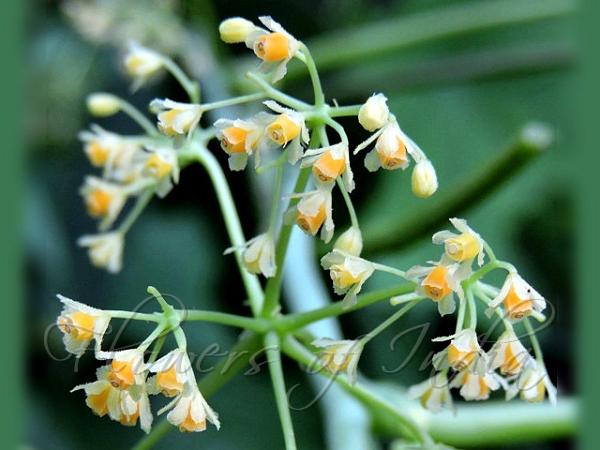|
| Hairless Tape Vine |
|

|

| File size | 94074 |
| Original date | 7/29/16 11:27 AM |
| Resolution | 640 x 480 |
| Flash | Flash did not fire, auto |
| Focal length | 8.4mm |
| Exposure time | 1/160s |
| Aperture | 3.5 |
| Focus Distance | |
| Metering Mode | Multi-segment |
| Camera make | NIKON |
| Camera model | COOLPIX P530 |
| Sensor type |
|
|
|
|
Photo: |
Botanical name: Stephania glabra Family: Menispermaceae (Moonseed family)
Hairless Tape Vine is a climbing herb. Roots are
tubers with fibrous roots below, round or oval also with irregular
shapes, grayish white, weighing about 5-20 kg. Leaves are ovate or
round, blunt at tip, 4-15 x 4-12 cm, hairless, 5-nerved; leaf-stalks
5-14 cm long, thickened at base. Male flowers are borne in leaf-axils,
in umbel-like cymes; flower-cluster-stalks 4-8 cm long, hairless;
bracts and bracteoles linear or linear-lanceshaped, hairless. Sepals
are 6; outer ones narrow-oblong; inner ones obovate. Petals are 3,
1.5-2 mm long. Female flowers: ovary oblong-ovoid; style short; stigma
4-5-cleft. Infructescence up to 15 cm long. Drupes are stalked, ovoid,
about 5 x 6 mm; endocarp transversely ribbed and grooved; embryo about
4 mm long; cotyledons oblong, blunt at tip. Hairless Tape Vine is found
in Uttarkhand, Assam and Meghalaya, at altitudes of 1000-2500 m.
Flowering: May-April.
Medicinal uses: The root is very bitter. It is
used in the treatment of pulmonary tuberculosis, asthma, abdominal
pains and dysentery. Root extracts have a long-standing reputation in
India as an antidysenteric, antipyretic and antiasthmatic.
The root is very bitter. It is
used in the treatment of pulmonary tuberculosis, asthma, abdominal
pains and dysentery. Root extracts have a long-standing reputation in
India as an antidysenteric, antipyretic and antiasthmatic.
Medicinal uses:
 The root is very bitter. It is
used in the treatment of pulmonary tuberculosis, asthma, abdominal
pains and dysentery. Root extracts have a long-standing reputation in
India as an antidysenteric, antipyretic and antiasthmatic.
The root is very bitter. It is
used in the treatment of pulmonary tuberculosis, asthma, abdominal
pains and dysentery. Root extracts have a long-standing reputation in
India as an antidysenteric, antipyretic and antiasthmatic. | Identification credit: Anil Thakur | Photographed in Hamirpur, Solan, HImachal Pradesh. |
• Is this flower misidentified? If yes,